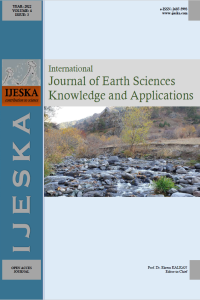A New Species of Patelloida (Gastropoda: Lottiidae) from Western Bo Ron Ga Island, Northern Rakhine Coastal Region, Myanmar
Abstract
Lottiid limpets (Lottiidae, genus Patelloida) occur on the rocky shore of the upper intertidal zone in marine habitats, providing many ecosystem goods and services. In this study, the species identification of an “adulterant” limpet with a small body size, which is often misidentified as a “young individual” of other sympatric species, including P. saccharina and P. novacula, was determined for the first time, based on molecular markers (partial mitochondrial cox1 and rrnL genes), phylogenetic analysis, and morphometric approaches. This novel species, P. arakanensis, commonly known as the “boulder limpet” in Myanmar, appears to potentially influence the efficiency of P. novacula. Phylogenetic analyses confirm its status as the basal taxon of the Indo-Pacific Patelloida. A comparative study of the shell characteristics of P. arakanensis, and other Patelloida species revealed several distinctive morphological traits, including generally smaller body size, a deeply cupped shell that is convex in adults but flat in young individuals. Other distinctive features of the new species include growth concentric line traits that are unique compared with the sympatric P. novacula and P. saccharina species, such as a deeper growth line in the fast-growth phase after settlement, followed by a significantly shallower growth line and mass disperse during subsequent life stages. This study provides the basic information necessary for further ecological and population genetic studies on this new species.
Keywords
Lottiid limpet Mitochondrial gene Molecular identification New species Patelloida Phylogeny
References
- Angas, G.F., 1865. On the marine molluscan fauna of the province of South Australia: with a list of all the species known up to the present time; together with remarks on their habitats and distributions, etc. Proceedings of the Zoological Society of London 1865, 155-190.
- Burgess, R.M., Jendrisak, J.C., 2002. Analysis of inter- and intra-specific competition amongst intertidal limpets with different methods of feeding. Oecologia 53, 337-346.
- Cech, W.T., Tanner, H., Tinoco Jr. D.I., Weir, C.B., Zuker, H., Perlman, N., 2009. Classification and molecular evolution of the intertidal limpets Patella grarnduris L. (Mollusca: Prosobranchia) and Siphonaria oculus Kr. (Mollusca: Pulmonata). Physical Zoology 65, 140-156.
- Dahlberg, R.A., Dahlberg, C.J., Lund, C.E., 2003. Physio-genetical ecology and intertidal zonation in limpets (Acmaea): A critical look at limiting factors. Biological Bulletin 142, 389-422.
- Dunker, W., 1860. Neue japanische Mollusken. Malakozoologische Blätter 6, 221-240.
- Dunker, W., 1861. Mollusca Japonica descripta et tabulis tribus iconum. E. Schweizerbart, Stuttgart, iv+36 pp.
- Edmonds, C.E., Vaughn, T., 2007. The ecology of intertidal gastropods. Academic Press, 245 pp.
- Eisen, J.A., 1998. Phylogenomics: Improving functional predictions for uncharacterized genes by evolutionary analysis. Genome Research 8, 163-167.
- Forster, J., Symons, S., 2009. Phylogenetic changes and shell taxonomic outgroup of tree topology. Conservation Biology 63, 241-245.
- Funk, D.J., Omland, K.E., 2003. Species-level paraphyly and polyphyly: Frequency, causes, and consequences, with insights from animal mitochondrial DNA. Annual Review of Ecology Evolution and Systematics 34, 397-423.
- Habe, T., Kosuge, S., 1996. Shells of the world in colour. Vol.II. The tropical Pacific. Osaka, Hoikusha, 193 p.
- Hedley, C., 1915. Studies on Australian Mollusca. Part XII. Proceedings of the Linnean Society of New South Wales 39, 695-755.
- Hutton, F.W., 1880. Manual of the New Zealand Mollusca. A systematic and descriptive catalogue of the marine and land shells, and of the soft polyzoa of New Zealand and adjacent islands. Wellington: Colonial Museum and Geological Survey Department. xvi, iv, 224.
- Iredale, T., 1924. Results from Roy Bell’s molluscan collections. Proceedings of the Linnean Society of New South Wales 49 (3), 179-278.
- Keegan, R.L., Gill, B., Ptashne, J.M., 2007. Life-histories of limpets and the limpet-phylogenies relationship. Journal of Experimental Marine Biology and Ecology 44, 25-50.
- Linnaeus, C., 1758. Systema Naturae per regna tria naturae, secundum classes, ordines, genera, species, cum characteribus, differentiis, synonymis, locis. Vol. 1. Laurentius Salvius: Holmiae, 824 pp.
- Mangel, W.F., Chamberlin, M.J., 2004. Molecular phylogeny of marine limpet genus Patelloida (Gastropoda: Lottiidae) based on mitochondrial DNA analysis. Journal of Molecular Evolution 12 (1), 273-282.
- Menke, K.T., 1843. Molluscorum Novae Hollandiae specimen. Hannover: Libraria Aulica Hahniana. 46 pp.
- Naung-Naung-Oo, 2022. Estuarine and Marine Molluscs of Myanmar: Part I. LAP LAMBERT Academic Publishing, Germany, 77 pp.
- Pauling, D., Corey, J., Branson, L., 2006. Phylogeny of genus Thais (Gastropoda: Muricidae) as mitochondrial gene sequences. J. Mol. Tax. 32, 312-325.
- Quoy, J.R.C., Gaimard, J.P., 1834. Voyage de la corvette I’Astrolabe: exécuté par ordre du roi, pendant les années 1826-1827-1828-1829, sous le commandement de M.J. Dumont d’Urville. Zoologie 3 (1), 1-366.
- Reeve, L.A., 1855. Monograph of the genus Patella. In: Conchologia Iconica, or illustrations of the shells of molluscous animals. L. Reeve & Co., London, 8, 1-42.
- Shaw, A., Feagin, S., Stuart, F., Simpson, K., 2005. Mitogenomes and phylogenetic analysis of true limpet. Mol. Gen. Taxa. 28, 162-174.
- Swofford, D.L., 2002. PAUP*: Phylogenetic Analysis Using Parsimony (*and Other Methods). Version 4, beta version. Sinauer Associates, Sunderland, Massachusetts, USA.
Details
| Primary Language | English |
|---|---|
| Subjects | Geological Sciences and Engineering (Other) |
| Journal Section | Research Article |
| Authors | |
| Publication Date | December 30, 2022 |
| Published in Issue | Year 2022 Volume: 4 Issue: 3 |


